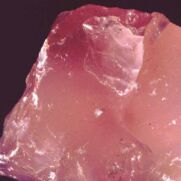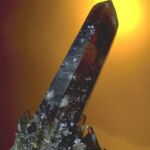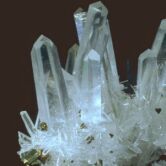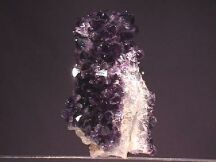
|
Quartz | ||||
|
Smokey quartz |
|
modified version from Harry W. Short National Drillers Buyers Guide Two of the most common elements in the earth's crust, oxygen and silicon, combine chemically in nature of form quartz. Quartz is found in igneous, metamorphic and sedimentary rocks; and in meteorites and rock samples from the moon. It is an important economic mineral and has numerous applications that are beneficial in our daily lives. Primitive man learned to make weapons and tools from the noncrystalline varieties of quartz such as flint, chert and jasper. Clear quartz was named "Krystalles" by the ancient Greeks; there are several biblical references about quartz bearing stones used as adornments. The Sumerians were first to recognize the value of agate, a noncrystalline colourful variety of quartz, to make jewelry and mastered the art of engraving, polishing and cutting ornamental stones into various shapes. They developed crude drilling tools and made beads out of carnelian and agates. Many practical objects, such as cups, bowls and bottles were hand carved form agate by the early man; agate mortars were used to grind drugs by ancient apothecaries. Emperor Nero had a two-handled agate wine cup that was obtained by the French in the ninth century and was used for several centuries in the coronation ceremonies of French Kings. Theophratus (372-287 B.C.) was the first man to write about agates from deposits along the Achates River in Sicily. Pliny the Elder (23-79 A.D.) wrote of agates in his "Natural History" from numerous locations other than Sicily. However neither of these writers mentioned anything about them being fashioned into gems. Over two hundred varieties and sub varieties of quartz, (SiO2, silicon dioxide) are known to exist. Quartz is a combination of silicon from the Latin word "silex" meaning flint and oxygen; translated from the Greeks, it literally means "acid former". Grains of quartz of all types of rocks are important constituents in gravel and sand deposits. The specific gravity (S.G) of quartz is 2.6 and a hardness of 7 on Mohs Scale of Hardness. It crystallizes in a long, slender prismatic shape in a hexagonal system with a rhombohedron on each end. Varieties of quartz displaying a specific form or shape are referred to as crystalline and those showing no crystal shape are called amorphous. Large, clear, well-developed quartz crystals are found in granitic rocks and pegmatite dykes. We are most familiar with the clear, white quartz crystals, purple amethyst, and smokey quartz; adventurine, citrine, and sagenite are also cystalline varities. Examples of amorphous quartz include chert, flint, jasper and rose quartz. Amethyst supposedly could cure drunkenness. If a person is placed a purple amethyst crystal in their drinking water utensil it gave the illusion of being a wine. Quartz bearing rocks were carried in the mouth of Arabian camel drivers to prevent thirst and allowed them to make long trips across the desert without water. During the eighth century in Japan, quartz was thought to keep the body cool on a hot day. Clear, small quartz crystals named " Herkimer Diamonds" have been sold as diamonds to unwary buyers. Some people wear quartz crystal necklaces or carry a crystal in their pocket or purse for good luck. Quartz is known as a geologic thermometer depending on the temperature at which it crystallizes. The crystal shape it assumes indicates whether it formed above or below 573˚C and referred to as low and high temperature quartz. Hexagonal quartz crystals develop below 573˚C. Tridymite develops above 870˚C and forms platy orhtorhombic crystals; whereas crystobalite, when developed above 1470˚C, forms white cubic system crystals. Thus, quartz is an important mineral in studying the depositional nature of ore deposits. Sand, as we know it and that Johnny Cash sings about getting in his shoes in Florida, is quartz. Quartz is highly resistant to erosion and weathering because if its hardness and durability, After Mother Nature's weathering processes remove quartz from its host rock, its size reduced by abrasion (mechanical weathering) as it bounces along river and stream beds to a place of deposition. When deposited in oceans, the constant pounding on the shoreline by wave action continues to break it down into smaller particles. When the sea recedes, the sand may form into massive sandstone beds or quartzite. As the weathering, transporting, and redeposition cycles repeat themselves over and over throughout geologic time, the end product is a neatly pure quartz sand. Quartz sand is used for numerous purposes. Water treatment plants have large beds of sand where incoming water is filtered to remove particles of various materials. Quartz sand is used in abrasives, grindstones, bricks, soap, polishing powder, bearings in precision instruments, sandpaper, plaster and concrete. Manufacturing of window glass requires that the sand be perfectly white and ninety-nine percent pure silica. Clean sand can be melted and made into glass, but usually mixed with flux, modifiers, and stabilizers to lower its melting point. When quartz sand is heated to about 3,600 F, it produces a fused glass that is highly resistant to heat and sudden temperature changes. Quartz is also used in manufacturing porcelain and has a molding material in metal casting. Plates cut from quartz crystals are used for frequency control in radios, televisions, electronic communications equipment, and quartz controlled clocks and watches. Silicon, the primary constituent in quartz, has a strong affinity for oxygen and is prepared for use in the semiconductor industry by heating to remove the oxygen. Silicon in this form are hard, dark gray in colour with a metallic luster, and has the same crystaline structure as diamonds. Highly purified silicon is a poor conductor of electricity but when treated with other atoms allows current to flow and is beneficial for use in transistors, integrated circuits and photo-electric devices. It is highly heat resistant and tiny silicon chips are connected to make complex circuits in satellites, spacecraft, and computers. The next time you visit the beach to soak up a few rays and pop a couple of cool one's, wiggle your toes in the sand and enjoy. "Mother Nature" spent more time getting it there then we can imagine. Would life be different without quartz sand? |
"It crystallizes in a long, slender prismatic shape in a hexagonal system with a rhombohedron on each end. Varieties of quartz displaying a specific form or shape are referred to as crystalline and those showing no crystal shape are called amorphous"
Ask the gemologist more about the agates eh....
The hardest crystal that you can find is the diamond, with the hardness of 10. You can scratch a diamond with another diamond, but not with a quartz.
Are you an alcoholic?? Tell me if this thing works out for you.
Good luck....oh really??! I've got quite a number of quartz crystals in my collection.....selling at 1K per piece...any takers??
...especially chemical weathering....remember the covalent bondings?Very stable wan rite??
Yup...in the water treatment plants you can find these stacked beds of sand in the multimedia filter, besides garnet (S.G 4.5) and anthracite (S.G 1.6). The finer sand polishes the effluent.
Definitely......agree?? |
||
|
Hey...who stole my grape fruits...err...looks more like the amethyst, isn't it? |
|||||
|
Amethyst
|
|||||
 . .
Conchoidal fracture on a rose quartz |
|||||

Amethyst |
|||||



